
The bulbuls are a family, Pycnonotidae, of medium-sized passerine songbirds, and includes the greenbul, brownbul, leaflove, and bristlebill. The family is distributed across most of Africa and into the Middle East, tropical Asia to Indonesia, and north as far as Japan. A few insular species occur on the tropical islands of the Indian Ocean. There are over 150 species in 32 genera. While different species are found in a wide range of habitats, the African species are predominantly found in rainforest, whereas Asian bulbuls are predominantly found in more open areas.

True thrushes are medium-sized mostly insectivorous or omnivorous birds in the genus Turdus of the wider thrush family, Turdidae. The genus name Turdus is Latin for "thrush". The term "thrush" is used for many other birds of the family Turdidae as well as for a number of species belonging to several other families.

The yellow-browed bulbul, or golden-browed bulbul, is a species of songbird in the bulbul family, Pycnonotidae. It is found in the forests of southern India and Sri Lanka. The yellow-browed bulbul is mainly yellow on the underside and olive above with a distinct yellow brow. They are easily located by their loud calls but tend to skulk within foliage below the forest canopy. While its taxonomic classification has changed over time, it is currently the sole species within the monotypic genus Acritillas which is closely related to Hemixos.

The Seram golden bulbul is a species of songbird in the family Pycnonotidae. It is endemic to the Moluccas. Until recently, it was considered conspecific with the northern golden bulbul and the Buru golden bulbul. Its natural habitat is subtropical or tropical moist lowland forests.

Alophoixus is a genus of songbird in the bulbul family, Pycnonotidae found in south-eastern Asia.
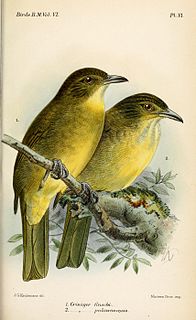
Finsch's bulbul is a species of songbird in the bulbul family, Pycnonotidae. It is found on the Malay Peninsula, Sumatra, and Borneo. Its natural habitat is subtropical or tropical moist lowland forests. It is threatened by habitat loss.

Criniger is a genus of songbirds in the bulbul family, Pycnonotidae. The species of Criniger are found in western and central Africa.
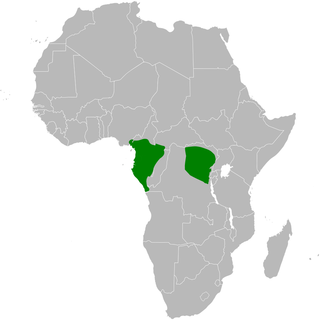
The eastern bearded greenbul is a species of songbird in the bulbul family, Pycnonotidae. It is found from south-eastern Nigeria to Central African Republic, north-eastern Democratic Republic of the Congo, Congo and extreme north-western Angola. Its natural habitats are subtropical or tropical moist lowland forests and subtropical or tropical moist montane forests.

Hemixos is a songbird genus in the bulbul family, Pycnonotidae.

Hypsipetes is a genus of bulbuls, songbirds in the family Pycnonotidae. Most of its species occur in tropical forests around the Indian Ocean. But while the genus is quite diverse in the Madagascar region at the western end of its range it does not reach the African mainland.
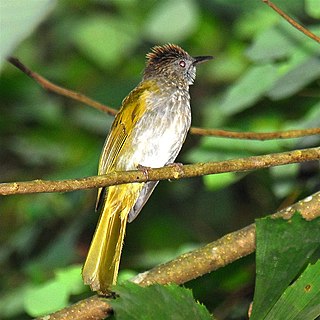
Ixos is a genus of passerine birds in the bulbul family, Pycnonotidae.

The streaked bulbul, or green-backed bulbul, is a songbird species in the bulbul family (Pycnonotidae). It is found on the Malay Peninsula, Sumatra, and Borneo. Its natural habitat is subtropical or tropical moist lowland forests. It is becoming rare due to habitat loss.

The sulphur-bellied bulbul is a songbird species in the bulbul family, Pycnonotidae. It is endemic to Palawan (Philippines). Its natural habitat is subtropical or tropical moist lowland forests. It is not considered a threatened species by the IUCN.
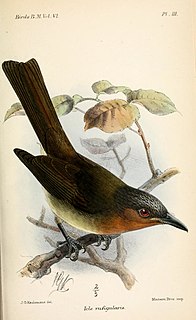
The Zamboanga bulbul is a songbird species in the bulbul family, Pycnonotidae. It is endemic to the Philippines, where its natural habitat is subtropical or tropical moist lowland forests of Basilan and the Zamboanga Peninsula. It is becoming rare due to habitat loss.

The streak-breasted bulbul, is a songbird species in the bulbul family, Pycnonotidae.
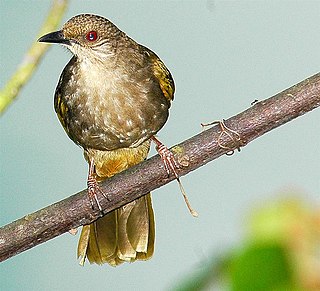
Pycnonotus is a genus of frugivorous passerine birds in the bulbul family Pycnonotidae.
Microscelis is a former genus of bulbuls.
The Mindoro bulbul is a songbird species in the bulbul family, Pycnonotidae.
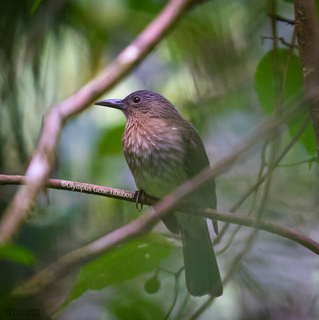
The Visayan bulbul or Steere's bulbul, is a songbird species in the bulbul family, Pycnonotidae.

















